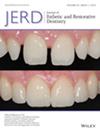Surface roughness and optical characteristics evaluations after chairside adjustment of different zirconia types
Abstract
Statement of Problem
Limited evidence is available for the effect of chairside adjustment using rotary cutting instruments on the surface roughness and optical properties of different zirconia types.
Purpose
To evaluate the effect of simulated adjustments on surface roughness and optical properties of different zirconia types.
Materials and Methods
Three Partially Stabilized Zirconia (PSZ) types based on mole percent yttria (Y) concentration from the same manufacturer (Katana; Kuraray) were used: 3Y-PSZ, 4Y-PSZ, and 5Y-PSZ. Thirty disk-shaped specimens (Ø14 × 1.2 mm) from different zirconia types (N = 90) were prepared. Specimens were either left without adjustment (NA), adjusted with Dialite ZR finishing and polishing system (Brasseler) (APol), or adjusted with course diamond instruments only (ADia). The specimens were distributed into 9 groups (n = 10): Group 3Y-PSZ/NA, Group 3Y-PSZ/APol, Group 3Y-PSZ/ADia, Group 4Y-PSZ/NA, Group 4Y-PSZ/APol, Group 4Y-PSZ/ADia, Group 5Y-PSZ/NA, Group 5Y-PSZ/APol, and Group 5Y-PSZ/ADia. The surface roughness of specimen was analyzed using an Atomic Force Microscope (AFM) (Bruker's Dimension Icon, Bruker) and Root Means Square (RMS) were recorded (nm). Surface Gloss (SG), Translucency Parameter (TP), and Contrast Ratio (CR) values of all groups were recorded using an integrating sphere spectrophotometer. Statistical analysis was performed using analysis of variance (ANOVA) and Tukey's multiple comparison tests for pairwise comparisons at p < 0.05 and 95% confidence interval.
Results
APol had no effect on the surface roughness (p = 0.88) while ADia had a significant negative effect (p < 0.05) despite the type of zirconia. Out of the three testes optical properties, only SG was negatively affected by ADia for all types of zirconia (p < 0.05). The two adjustment types did not affect the TP of all the tested zirconia (p = 0.91). The CR was not affected by the tested adjustments for all zirconia types (p = 0.726).
Conclusion
Proper zirconia adjustment following a sequence of burs and polishers can maintain acceptable roughness and optical properties. Adjustment of zirconia with rough diamond can lead to deleterious effects and should be avoided.
Clinical Significance
Chairside adjustment of zirconia could lead to rougher surface and unpredictable changes of surface gloss. Therefore, zirconia adjustment should be minimized to the greatest extent possible and a proper protocol should be followed if had to be done.

 求助内容:
求助内容: 应助结果提醒方式:
应助结果提醒方式:


